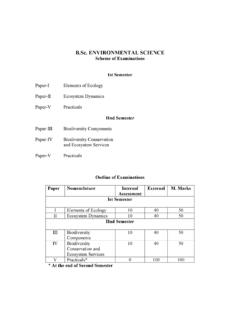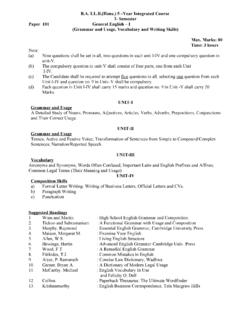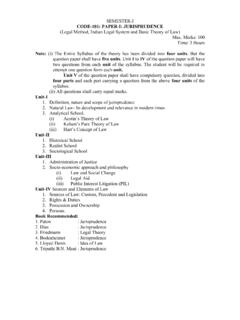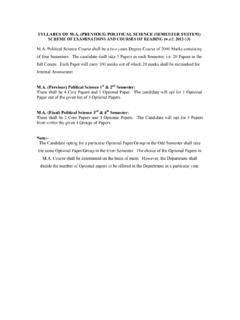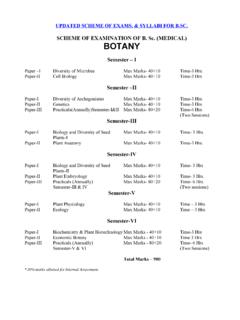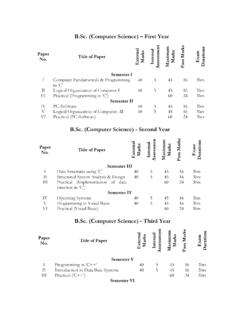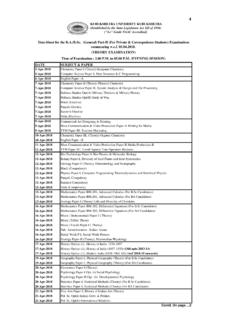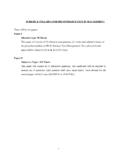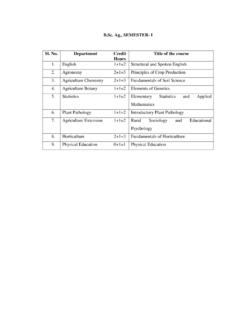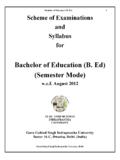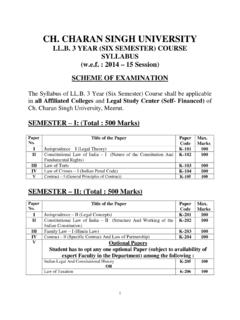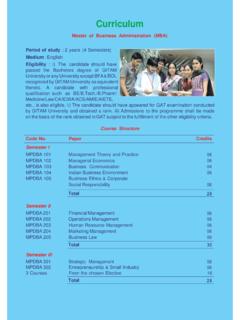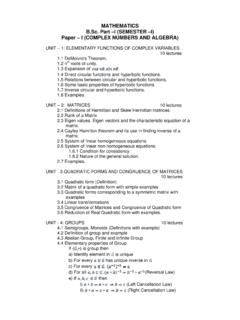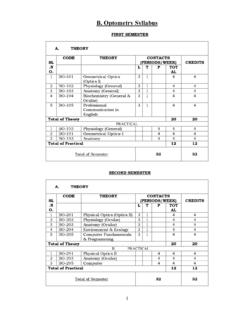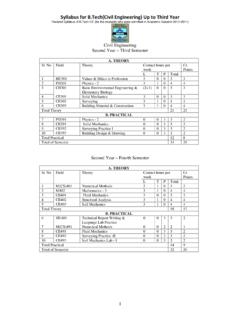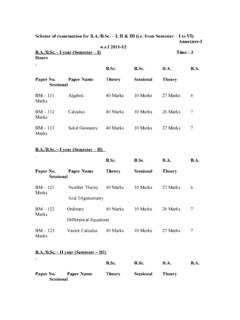Transcription of STATISTICS PAPER Scheme of Examination of B.A./B.Sc. three ...
1 STATISTICS PAPERS cheme of Examination of three year degree Course will be two theory papers of STATISTICS and Practical in / three year degree course Part-I, II & III consisting of two semesters each. Practical examinations will be held annually (based on constituent semesters). Part-I (Semester-I) Methods-I28+7*40+10*3 hoursIIST-102 Probability Theory28+7*40+10*3 hours(Semester-II)IST-201 Statistical Methods-II28+7*40+10*3 hoursIIST-202 Probability Distributions28+7*40+10*3 hoursIIIST-203 Practical60**100**3 hoursPart-II(Semester-III)IST-301 Elementary Inference28+7*40+10*3 hoursIIST-302 Sample Surveys28+7*40+10*3 hours(Semester-IV)IST-401 Parametric and Non-parametric tests28+7*40+10*3 hoursIIST-402 Design of Experiments28+7*40+10*3 hoursIIIST-403 Practical60**100**3 hoursPart-III(Semester-V)IST-501 Applied Statistics28+7*40+10*3 hoursIIST-502 Numerical Methods and Fundamentals of Computers 28+7*40+10*3 hours (Semester-VI)
2 IST-601 Statistical Quality Control 28+7*40+10*3 hoursIIST-602 Operations Research28+7*40+10*3 hoursIIIST-603 Practical60**100**3 hours* Marks of internal assessment based on the following criteria:(i)Two Handwritten Assignments : 10% (1st Assignment after one month & 2nd Assignment after two months)(ii)One Class Test : 5% (one period duration)(iii)Attendance : 5%Marks for attendance will be given as under:(1) 91% onwards:5 Marks (4) 70% to 75%:2 Marks**(2) 81% to 90%:4 Marks (5) 65% to 70% : 1 Marks**(3) 75% to 80%:3 Marks **For students engaged in co-curricular activities of the colleges only/authenticated medical grounds duly approved by the concerned Principal.
3 **Practical Examinations will be held annually in the even semesters i. e. II, IV & VI semester and distribution of marks will be as follows. Practical :48 80 Class Record:06 10 Viva-Voce:06 Semester-I PAPER -I(ST-101)Time:3 Hours :40+10* : 28+7* * Internal AssessmentStatistical Methods-INote: There will be nine questions in all. Question will be compulsory covering whole of the syllabus and comprising 5 to 8 short answer type questions. Rest of the eight questions will be set from the three sections. The candidate will be required to attempt five questions in all selecting at least one question from each section including the compulsory one.
4 All the questions will carry equal marks except the compulsory question, the distribution of marks for which will be as follows: marks and 6 (Two questions)Introduction of STATISTICS :Origin, development, definition, scope, uses and limitations. Types of Data: Qualitative and quantitative data, cross sectional and time series data, discrete and continuous data, frequency and non-frequency data. Nominal, ordinal, ratio and interval and Scrutiny of Data:Collection of primary and secondary data- its major sources including some government publications, scrutiny of data for internal consistency and detection of errors of recording, classification and tabulation of ( three questions)Presentation of Data:Frequency distribution and cumulative frequency distribution, diagrammatic and graphical presentation of data, construction of bar, pie diagrams, histograms, frequency polygon, frequency curve and ogives.
5 Measures of Central Tendency/Location:Arithmetic mean, median, mode, geometric mean, harmonic mean; partition values-quartiles, deciles, percentiles and their graphical location along with their properties, applications, merits and of Dispersion:Concept of dispersion, characteristics for an ideal measure of dispersion. Absolute and relative measures based on: range, inter quartile range, quartile deviation, coefficient of quartile deviation, Mean deviation, coefficient of mean deviation, standard deviation ( ), coefficient of variation and properties of these measures. Section-III ( three questions)Moments, Skewness and Kurtosis: Moments about mean and about any point and derivation of their relationships, effect of change of origin and scale on moments, Sheppard s correction for moments (without derivation), Charlier s checks; coefficients of Skewness and Kurtosis with their of Attributes: Symbolic notations, dichotomy of data, class frequencies, order of class frequencies, consistency of data, independence and association of attributes, Yule s coefficient of association and coefficient of colligation.
6 Books Title of BookName of author Publisher1. Applied StatisticsNeter J., Wasserman W., Allyn & Bacon, & Whitmore Inc. 2. Applied GeneralCroxton , Cowden Prentice Hall & Kelin S. 3. Fundamental ofGoon , Gupta , World Press, STATISTICS Vol. IDasgupta B. Calcutta 4. StatisticsJohnson R. Wiley Publishers 5. Basic StatisticsAggarwal New Age International 6. Fundamentals of Gupta Sultan Chand & Mathematical Kapoor Sons STATISTICS 7. Programmed Aggarwal New Age STATISTICS International8. An Introduction ToG. Udny, Kendal Charles Griffin Theory of STATISTICS and co.
7 Semester-I PAPER -II(ST-102)Time:3 Hours :40+10* : 28+7* * Internal AssessmentProbability TheoryNote: There will be nine questions in all. Question will be compulsory covering whole of the syllabus and comprising 5 to 8 short answer type questions. Rest of the eight questions will be set from the three sections. The candidate will be required to attempt five questions in all selecting at least one question from each section including the compulsory one. All the questions will carry equal marks except the compulsory question, the distribution of marks for which will be as follows: marks and 6 ( three questions)Concepts in Probability: Random experiment, trial, sample point, sample space, operation of events, exhaustive, equally likely and independent events; Definition of probability-classical, relative frequency, statistical and axiomatic approach, conditional probability.
8 Addition and multiplication laws of probability and their extension to n events. Boole s inequality; Bayes theorem and its applications. Section-II ( three questions)Random Variable and Probability Functions: Definition of random variable, discrete and continuous random variable, probability function, probability mass function and probability density functions, distribution function and its properties, functions of random variables, joint, marginal and conditional probability distribution Expectation: Definition and its properties-moments, addition and multiplication theorem of expectation. Conditional expectation and conditional variance. Section-III (Two questions)Generating Functions: Moments generating function, cumulant generating function, probability generating function along with their Title of BookName of author Publisher1.
9 Fundamentals of Gupta Sultan Chand Mathematical Kapoor & Sons STATISTICS 2. Probability forEdward , Ford Prentice Hall Statistical Decisionand Lin Making 3. ElementaryDavid S. Oxford Press Probability 4. Introduction to Hoel Asia Pub. House Mathematical Statistics5. New MathematicalBansi Lal & Satya Prakashan STATISTICS Arora Introduction toHogg and Craig Prentice Hall Mathematical Semester-II PAPER -I(ST-201)Time:3 Hours :40+10* : 28+7* * Internal AssessmentStatistical Methods-IINote: There will be nine questions in all.
10 Question will be compulsory covering whole of the syllabus and comprising 5 to 8 short answer type questions. Rest of the eight questions will be set from the three sections. The candidate will be required to attempt five questions in all selecting at least one question from each section including the compulsory one. All the questions will carry equal marks except the compulsory question, the distribution of marks for which will be as follows: marks and 6 (Two questions)Correlation: Concept and types of correlation, methods of finding correlation - scatter diagram, Karl Pearson s Coefficient of correlation (r), its properties, coefficient of correlation for a bivariate frequency distribution. Rank correlation with its derivation, its merits and demerits, limits of rank correlation coefficient, tied or repeated ranks, coefficient of determination.
